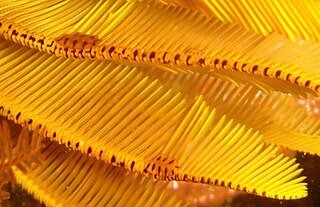
The Myzostomida or Myzostomatida are an order of small marine worms, which are parasitic on echinoderms, mostly crinoids. These highly unusual and diverse annelids were first discovered by Friedrich Sigismund Leuckart in 1827.

The deepwater burrfish is a porcupinefish of the family Diodontidae, found off southern Australia, central and northern New Zealand, and in the Tasman Sea. It occurs at depths of 40 to 270 m in areas off the continental shelf. The species reaches 50 cm in total length and is reportedly easily entangled in nets due to its spines and ability to inflate its body. It is the only known member of its genus.

Heteroconchia is a taxonomic infraclass of diverse bivalve molluscs, belonging to the subclass Autobranchia.

Atlanta is a genus of pelagic marine gastropod molluscs in the family Atlantidae. They are sometimes called heteropods.

Carcharias is a genus of mackerel sharks belonging to the family Odontaspididae. Once bearing many prehistoric species, all have gone extinct with the exception of the critically endangered sand tiger shark.

Latiaxis is a genus of medium-sized sea snails, marine gastropod mollusks in the family Muricidae, subfamily Coralliophilinae, the coral snails or coral shells.
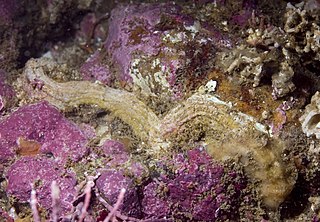
The Vermetidae, the worm snails or worm shells, are a taxonomic family of small to medium-sized sea snails, marine gastropod molluscs in the clade Littorinimorpha. The shells of species in the family Vermetidae are extremely irregular, and do not resemble the average snail shell, hence the common name "worm shells" or "worm snails".

Hipponicidae, common name hoof shells or hoof snails, is a family of small sea snails, limpet-like marine gastropod molluscs in the superfamily Vanikoroidea.

Verticordiidae is a family of benthic marine bivalves in the superorder Anomalodesmata. These clams range from 2 - 200 millimeters in length and are mainly found in coastal waters surrounding Australia and the Americas, though a few species within this family such as Haliris mediopacifica are found in the middle of the ocean. Verticordiidae is known for being a family of septibranchs, or predatory bivalves, rather than filter feeders. Clams dig vertical burrows in substrate and use papillae around the edges of their inhalant siphons to detect microscopic prey. Some clams in this family, specifically in the genus Trigonulina, have distinct extended circular formations on their shells.
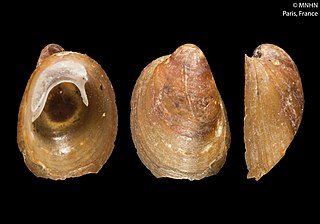
Crepidula, commonly known as the slipper snails, slipper limpets, or slipper shells, is a genus of sea snails, marine gastropod mollusks in the family Calyptraeidae. This family includes the slipper snails (Crepidula), hat snails (Calyptraea), spiny slipper snails (Bostrycapulus), and cup-and-saucer snails (Crucibulum) as well as Crepipatella, Siphopatella, Grandicrepidula, and Maoricrypta.
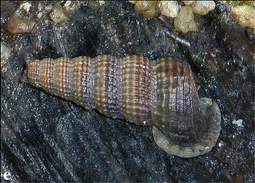
Cerithidea is a genus of medium-sized sea snails or mud snails, marine gastropod mollusks in the family Potamididae, the horn snails.
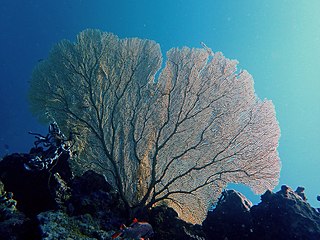
Scleraxonia is a suborder of corals, a member of the phylum Cnidaria.

Chilomycterus is a genus of diodontid tetraodontiform fishes commonly called "burrfish."

Haliclystidae is a family of stalked jellyfish in the order Stauromedusae.

Rhizostomatidae is a family of cnidarians in the class Scyphozoa.
Haliris is a genus of the class Bivalvia of the family Verticordiidae.

Dallinidae is a family of loopbearing brachiopods belonging to the order Terebratulida.
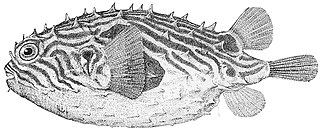
Chilomycterus spinosus, sometimes known as the brown burrfish, is a species of burrfish in the family Diodontidae. It is native to the southwestern Atlantic Ocean, where it ranges from Venezuela to Argentina, including the island of Trinidad. It is known to occur in both marine and brackish environments, where it is typically found at a depth of 70 to 190 m. The species reaches 28 cm in total length and can weigh up to at least 12.21 grams.
Cyclichthys hardenbergi, commonly known as Hardenburg's burrfish, is a species of porcupinefish in the family Diodontidae. It is native to the tropical western Pacific Ocean, where it is known from southern New Guinea and northern Australia east of Cape York. The species is typically seen at depths of less than 100 m (328 ft) over soft substrates. It is believed to be a solitary species that feeds on hard-shelled invertebrates. The species reaches 25 cm in standard length. Although sometimes caught by trawling, it is not a target for commercial fisheries.
















